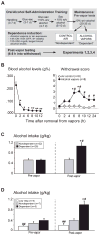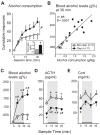Alcohol self-administration acutely stimulates the hypothalamic-pituitary-adrenal axis, but alcohol dependence leads to a dampened neuroendocrine state
- PMID: 18979677
- PMCID: PMC2748838
- DOI: 10.1111/j.1460-9568.2008.06455.x
Alcohol self-administration acutely stimulates the hypothalamic-pituitary-adrenal axis, but alcohol dependence leads to a dampened neuroendocrine state
Abstract
Clinical studies link disruption of the neuroendocrine stress system with alcoholism, but remaining unknown is whether functional differences in the hypothalamic-pituitary-adrenal (HPA) axis precede alcohol abuse and dependence or result from chronic exposure to this drug. Using an operant self-administration animal model of alcohol dependence and serial blood sampling, we show that longterm exposure to alcohol causes significant impairment of HPA function in adult male Wistar rats. Acute alcohol (voluntary self-administration or experimenter-administered) stimulated the release of corticosterone and its upstream regulator, adrenocorticotropic hormone, but chronic exposure sufficient to produce dependence led to a dampened neuroendocrine state. HPA responses to alcohol were most robust in 'low-responding' non-dependent animals (averaging < 0.2 mg/kg/session), intermediate in nondependent animals (averaging approximately 0.4 mg/kg/session), and most blunted in dependent animals (averaging approximately 1.0 mg/kg/session) following several weeks of daily 30-min self-administration sessions, suggesting that neuroendocrine tolerance can be initiated prior to dependence and relates to the amount of alcohol consumed. Decreased expression of corticotropin-releasing factor (CRF) mRNA expression in the paraventricular nucleus of the hypothalamus and reduced sensitivity of the pituitary to CRF may contribute to, but do not completely explain, neuroendocrine tolerance. The present results, combined with previous studies, suggest that multiple adaptations to stress regulatory systems may be brought about by excessive drinking, including a compromised hormonal response and a sensitized brain stress response that together contribute to dependence.
Figures





References
-
- Adinoff B, Risher-Flowers D, De Jong J, Ravitz B, Bone GH, Nutt DJ, Roehrich L, Martin PR, Linnoila M. Disturbances of hypothalamic-pituitary-adrenal axis functioning during ethanol withdrawal in six men. Am J Psychiatry. 1991;148:1023–1025. - PubMed
-
- Alheid GF, Heimer L. New perspectives in basal forebrain organization of special relevance for neuropsychiatric disorders: the striatopallidal, amygdaloid, and corticopetal components of substantia innominata. Neuroscience. 1988;27:1–39. - PubMed
-
- Baldwin HA, Rassnick S, Rivier J, Koob GF, Britton KT. CRF antagonist reverses the “anxiogenic” response to ethanol withdrawal in the rat. Psychopharmacology (Berl) 1991;103:227–232. - PubMed
Publication types
MeSH terms
Substances
Grants and funding
LinkOut - more resources
Full Text Sources
Other Literature Sources
Medical

